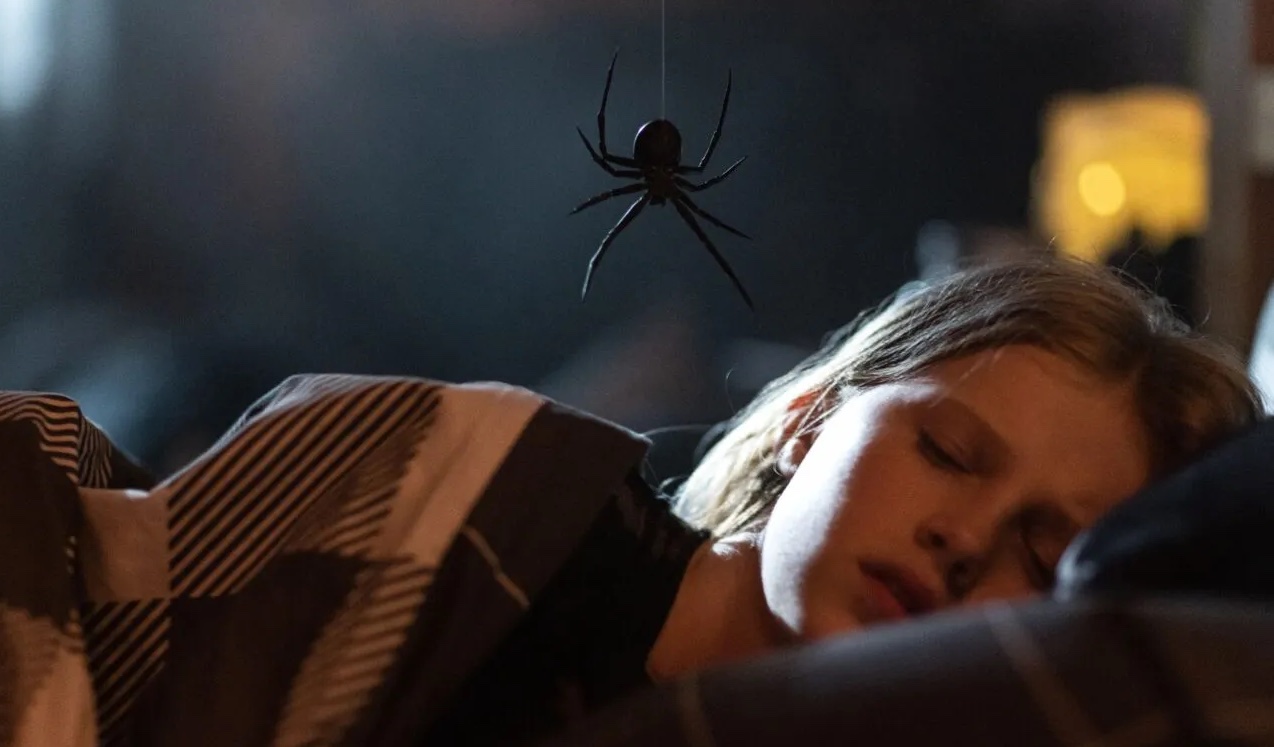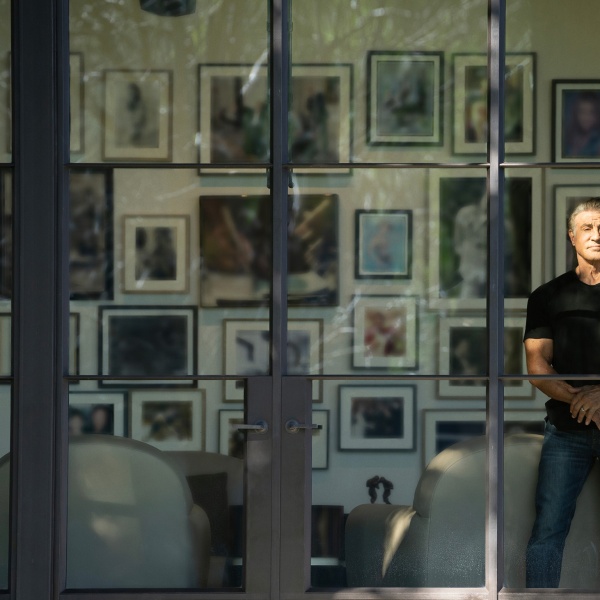The redback spider, also known as the Australian black widow, is the kind of creature that might shake a person’s belief in God. This Lovecraftian nightmare freak hunts its prey with balletic precision and squirts them with organic superglue before injecting them with a venom that liquifies their insides; it then binds the victim in a silk straightjacket so that they’re still alive when the redback drinks their organs. It mostly feeds on insects, but has been known to devour lizards, snakes, and even mice. The spider’s toxin is powerful enough to kill a human being if left untreated, and is especially harmful to small children. The good news is that an antivenom has been available since 1956. The bad news is that people have had ample reason to use it, as the redback thrives in the dampness of modern architecture, and counts mailboxes and the underside of toilet seats among its favorite hiding spots.
In other words, Latrodectus hasselti doesn’t need much of a glow-up to star in a creature feature — it’s already one of the most terrifying critters on Earth. What “Wyrmood” director Kiah Roache-Turner’s “Sting” presupposes is… what if one of these eight-legged killing machines wasn’t from Earth? What if it rode into our atmosphere aboard a comet that crash-landed into a dilapidated New York City apartment building, and was then adopted by an emotionally fragile pre-teen girl who named it after Bilbo Baggins’ favorite sword and thought it was cool that her new pet doubled in size every time it fed, the spider eventually growing large enough for its human prey to appreciate the details of its freaky alien face before it ate them alive? Would that be bad? Spoiler alert: Yes. Yes it would. (Fun fact: Spiders can easily survive impact at terminal velocity, and so the premise of a redback landing on its feet after plummeting from the stratosphere isn’t quite as far-fetched as it sounds).
And yet, the idea of an actual redback spider coming to nest in Eric Adams’ New York is so terrifying to begin with that “Sting” doesn’t have much to gain from its extraterrestrial twist. As a Brooklyn-based arachnophobe who lives in a more realistic version of the homey but sprawling apartment set that Roache-Turner and his team built in downtown Sydney, I was much twitchier and more unsettled during the first half of this movie — when Sting is hiding in kitchen cabinets and what not — than I was during the second half, when Sting is clambering through the building’s air ducts like an 18-wheeler trying to squeeze through the Holland Tunnel. There’s decent fun to be had in this crafty and contained Aussie skin-crawler (a low-budget affair that doesn’t scrimp when it comes to its WETA-created monster), but “Sting” is a bit too small for its massive alien spider to maneuver itself in unexpected ways, and the tender human story that Roache-Turner weaves around her lacks the bite it needs to melt your heart or liquify any of your other organs.
At the same time, however, Roache-Turner’s script is smart to recognize that spiders — even the super fucked up ones that drink their victims like organic milkshakes — are scarier for the fear they trigger than for the threat they represent. In fact, 12-year-old Charlotte (Aylya Browne) is so cool with arachnids that she can hardly contain her smile when she first discovers Sting hiding in her grandmother’s dollhouse (the film’s credit sequence, in which the spider crawls through that dollhouse at a scale that teases its eventual size, promises a degree of cleverness that “Sting” is never quite able to match). A friendless, goth-adjacent tween who hopes to bond with her fraying stepfather Ethan (Ryan Corr) over the co-creation of their comic book “Fang Girl,” Charlotte seems like the type who might’ve been rooting for Shelob in “The Return of the King.” The only thing this plucky young adult is afraid of is losing what’s left of her place in the family, which feels like a distinct possibility now that her mother (Penelope Miller) and Ethan have a new baby boy all their own.
But Charlotte is good at keeping her fears at bay — she’s so good at it that she doesn’t even bat an eye when she learns that her new pet spider can parrot virtually any basic sound it hears (a severely under-utilized talent in the film). “Spiders don’t have vocal cords,” cautions Erik, the introverted and kinda sinister biology student who lives in one of the apartments upstairs (Danny Kim), “that is not a spider.” But whatever, that just makes Sting special. Besides, everything and everyone in New York is vaguely threatening to some degree; that’s what gives this city its character, and Roache-Turner is right to populate Charlotte’s building with all sorts of weirdos and creeps.
Few of them make strong impressions, but “Sting” — which takes place during a historic ice storm that keeps everyone cooped up inside — does what it can to seize on the strange mix of apathy and intimacy that apartment life can breed. It’s a feeling best expressed by Charlotte’s senile grandmother, who kicks off the film with an ominous flash-forward in which she calls an exterminator to deal with the spider problem… after forgetting that the last exterminator she hired never came out of the bedroom (the latest victim is played by a very funny Jermaine Fowler, perfecting some classic “I’m not getting paid enough for this” schtick as he shakes his head at the mysterious goo oozing out of the old lady’s radiator).
“Sting” unfolds with precious few surprises: The spider escapes its enclosure and jump-scares a few randos to death while the situation deteriorates in Charlotte’s apartment. The kills are competent if never particularly inspired, and the corpses are shriveled if never particularly gruesome. Vocal cords aside, Roache-Turner’s general adherence to the look and behavior of a redback spider is at odds with Sting’s extraterrestrial origins, and often feels as if it’s putting bumper lanes on the slaughterhouse of his imagination (at least WETA’s emphasis on puppetry over CGI allows these murders to retain their all too earthly arachnophobic thrill).
The same could be said of the apartment complex where the vast, vast majority of this movie takes place, which becomes less of a feature than a bug due to the obviousness of Roache-Turner’s foreshadowing — struggling cartoonist Ethan moonlights as the building’s super, and marvels at the trash compactor whenever he can — and the limited number of places where a spider the size of a German Shepherd might hide in an NYC residence. The logistical flaws of the film’s location eventually overwhelm the benefits that Roache-Turner mines from setting this story in such a pressure cooker of cloistered domesticity, where neither Charlotte nor Ethan can escape the desperate struggle to live together as a family.
The actors share a genuine sweetness, which “Sting” needs in order to sell its young heroine’s ultra-abrupt pivot from “Sting is my best friend!” to “Sting kidnapped my baby half-brother and must be killed with extreme prejudice!,” and Roache-Turner occasionally hits upon an image that’s nightmare-inducing enough to justify his choices (e.g. the shadow of a giant spider hovering over a crib), but the filament holding this story together is never as strong as the webbing that Sting uses to glue her adult human prey to an elevator shaft. By the time “Sting” arrived at its obligatory sequel tease of a last shot, the threat posed by the movie’s alien spider felt much less frightening to me than the threat posed by its smaller cousins here on Earth. Well, not here on Earth, thank god, but maybe in the part of the planet where you live.
Grade: C
Well Go USA will release “Sting” in theaters on Friday, April 12.





